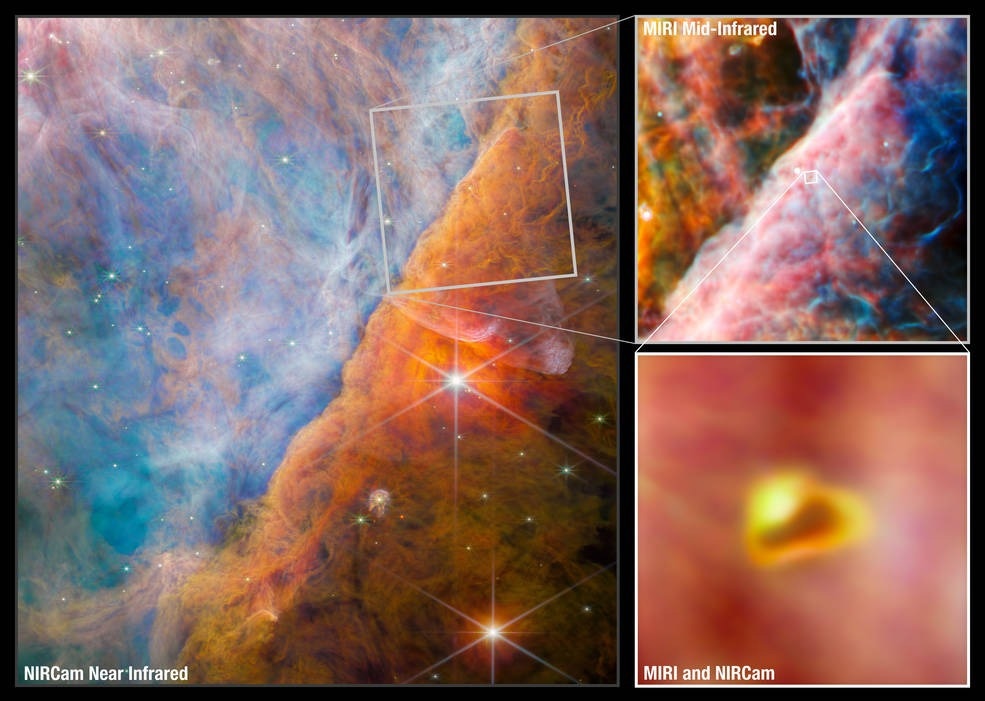To detect the existence of a new carbon compound in space for the first time, a team of international scientists has made use of NASA’s James Webb Space Telescope.
 These Webb images show a part of the Orion Nebula known as the Orion Bar. The largest image, on the left, is from Webb’s NIRCam (Near-Infrared Camera) instrument. At upper right, the telescope is focused on a smaller area using Webb’s MIRI (Mid-Infrared Instrument). At the very center of the MIRI area is a young star system with a protoplanetary disk named d203-506. The pullout at the bottom right displays a combined NIRCam and MIRI image of this young system. Image Credit: ESA/Webb, NASA, CSA, M. Zamani (ESA/Webb), and the PDRs4All ERS Team.
These Webb images show a part of the Orion Nebula known as the Orion Bar. The largest image, on the left, is from Webb’s NIRCam (Near-Infrared Camera) instrument. At upper right, the telescope is focused on a smaller area using Webb’s MIRI (Mid-Infrared Instrument). At the very center of the MIRI area is a young star system with a protoplanetary disk named d203-506. The pullout at the bottom right displays a combined NIRCam and MIRI image of this young system. Image Credit: ESA/Webb, NASA, CSA, M. Zamani (ESA/Webb), and the PDRs4All ERS Team.
The new molecule, called methyl cation (pronounced cat-eye-on) (CH3+), is significant as it aids in the formation of highly complicated carbon-based molecules. The methyl cation was found in a young star system, which had a protoplanetary disk called d203-506. It was situated around 1,350 light-years away in the Orion Nebula.
Carbon compounds make the foundations of all known life, and as such, are specifically attractive to researchers working to comprehend how life developed on Earth and how it can develop somewhere else in the universe. The study of interstellar organic (carbon-containing) chemistry, which Webb is paving the way in new means, is an area of keen interest to several astronomers.
The exclusive abilities of Webb made it a perfect observatory to look for this key molecule. The Webb’s fine spatial and spectral resolution, and also its sensitivity, all added up to the team’s success. Especially, Webb’s detection of a series of main emission lines from CH3+cemented the breakthrough.
This detection not only validates the incredible sensitivity of Webb but also confirms the postulated central importance of CH3+ in interstellar chemistry.
Marie-Aline Martin-Drumel, Science Team Member, the University of Paris-Saclay
While the star in d203-506 is known to be a small red dwarf, the system has been bombarded by strong ultraviolet (UV) light from hot, young, and massive stars in proximity. Researchers think that the majority of the planet-forming disks experience a period of such intense UV radiation, as stars tend to form in groups that always include huge, UV-producing stars.
Generally, complex organic molecules are expected to be destroyed by UV radiation, insohe breakthrough of CH3+ may look like a surprise. But the team forecasts that UV radiation may offer the essential source of energy for CH3+ to be developed in the first place. As soon as it is developed, it further promotes extra chemical reactions to construct highly complicated carbon molecules.
Widely, the team believes that the molecules they perceive in d203-506 are very different from normal protoplanetary disks. Especially, any signs of water could not be detected by the researchers.
This clearly shows that ultraviolet radiation can completely change the chemistry of a protoplanetary disk. It might play a critical role in the early chemical stages of the origins of life.
Olivier Berné, Study Lead Author, French National Center, Scientific Research in Toulouse